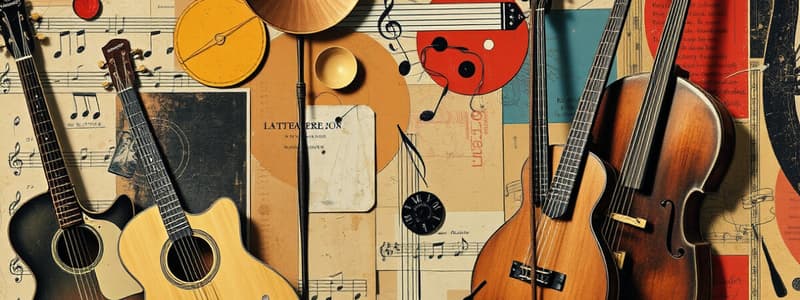Podcast
Questions and Answers
What distinguishes the sound produced by smaller and larger musical instruments?
What distinguishes the sound produced by smaller and larger musical instruments?
- Larger instruments produce faster vibrations and higher sound.
- Smaller instruments produce slower vibrations and lower sound.
- Larger instruments produce slower vibrations and softer sound.
- Smaller instruments produce faster vibrations and higher sound. (correct)
Which property of musical sound refers to the force with which a tone is heard?
Which property of musical sound refers to the force with which a tone is heard?
- Timbre
- Volume (correct)
- Duration
- Pitch
In the classification of wind instruments, which category is NOT mentioned?
In the classification of wind instruments, which category is NOT mentioned?
- Strings (correct)
- Brasses
- Woodwinds
- Percussion
What does the term 'timbre' refer to in the context of musical sounds?
What does the term 'timbre' refer to in the context of musical sounds?
What is one form of realism in art as described in the content?
What is one form of realism in art as described in the content?
Flashcards are hidden until you start studying
Study Notes
Types of Musical Instruments
- Musical instruments are classified into three main types: string instruments (bowed), wind instruments (blown), and percussion instruments (struck).
- Wind instruments are divided into two categories: brass instruments, typically made of brass, and woodwind instruments, originally crafted from wood.
- Modern flutes and piccolos are primarily composed of metal.
Characteristics of Instruments
- Instruments are ranked in order of pitch; smaller instruments have higher pitch due to faster vibrations, while larger instruments produce lower sounds through slower vibrations.
Properties of Musical Sounds
- Four essential properties define musical sounds:
- Pitch: Refers to the highness or lowness of a tone in the musical scale.
- Duration: Indicates the length of time over which the sound vibration is maintained, ranging from short to long tones.
- Volume: Corresponds to the loudness or softness of a tone, with terms such as forte (loud) and piano (soft).
- Timbre (Tone Color): Describes the unique quality or color of sound produced by different instruments.
Realism in Art
- Realism aims for objectivity, with artists focused on accurately describing observations through the senses.
- Artists may be influenced by personal feelings and thoughts during the selection and presentation of their material.
Abstraction in Art
- Abstraction occurs when artists focus on specific aspects of a scene, often omitting objective reality to express their ideas or emotions.
- The term "abstract" suggests a movement away from concrete representation.
Studying That Suits You
Use AI to generate personalized quizzes and flashcards to suit your learning preferences.




